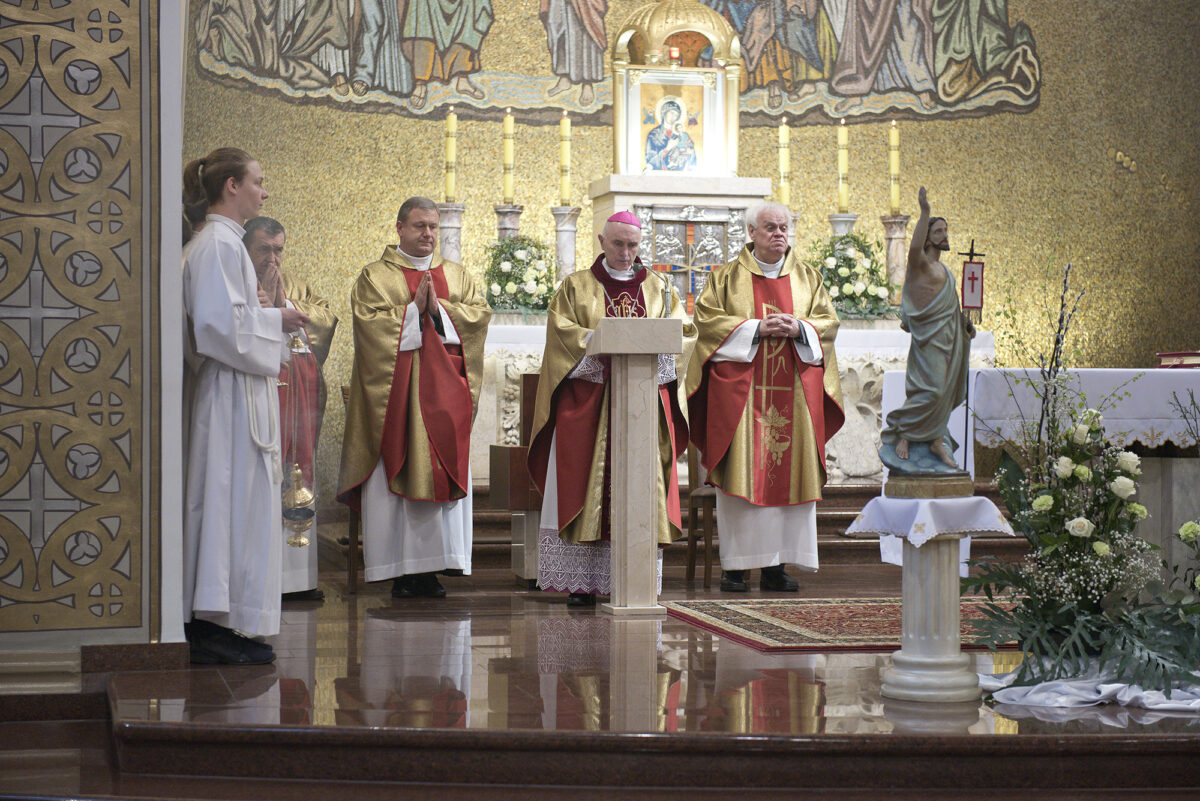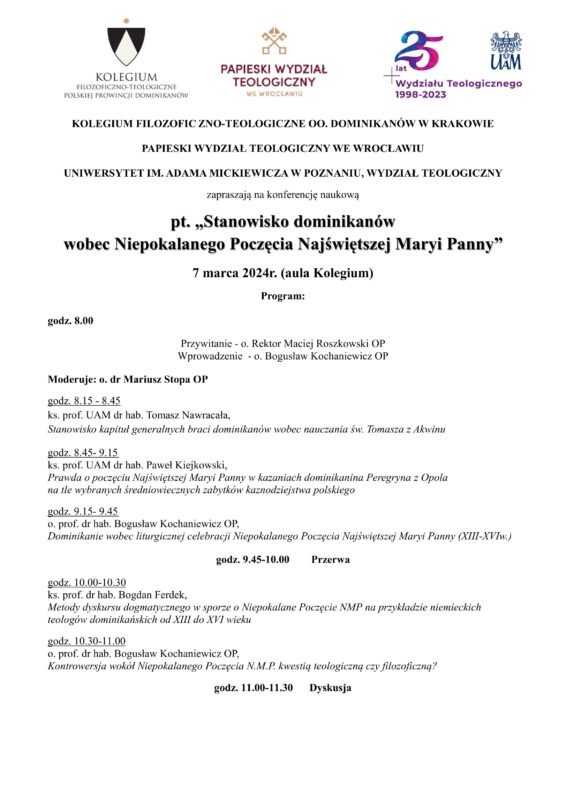Eucharystia od Wieczernika przez wieki aż do dzisiaj
Wiara poszukuje zrozumienia. Wiara w Boga, który jest Logosem, musi być wiarą rozumną. Rozumną musi być również wiara w Najświętszy Sakrament.
Najświętszy Sakrament wyróżnia się wśród innych sakramentów tym, że nie tylko skutecznie udziela łaski lecz znaki chleba i wina, poprzez które udzielana jest łaska, stają się Ciałem i Krwią Chrystusa. Dla porównania w sakramencie chrztu woda staje się skutecznym znakiem łaski, ale nie zmienia się sama natura wody. Przed chrztem, w czasie chrztu i po chrzcie woda pozostaje tą samą wodą. Natomiast w Najświętszym Sakramencie chleb i wino stają się nie tylko skutecznym znakiem łaski lecz przestają być chlebem i winem stając się Ciałem i Krwią Chrystusa. Najświętszy Sakrament jest więc nie tylko sakramentem, ale i obecnością Ciała i Krwi Jezusa pod postaciami chleba i wina. Spróbujmy zatem przedstawić najważniejsze próby zrozumienia wiary w obecność Ciała i Krwi Jezusa pod postaciami chleba i wina podejmowane na przestrzeni wieków.

Punktem wyjścia do zrozumienia wiary w obecność Ciała i Krwi Jezusa pod postaciami chleba i wina jest Wieczernik, gdzie Jezus nad chlebem i winem wypowiedział słowa: „To jest Ciało moje”, „To jest Kielich Krwi mojej”. Te słowa nie są porównaniem. Z definicji bowiem porównywane przedmioty muszą mieć jakiś wspólny mianownik – jakąś wspólną jakość przynależną obu porównywanym przedmiotom. Chleb i ciało, wino i Krew nie mają jakiejś wspólnej jakości. O tym, że słowa Jezusa wypowiedziane w Wieczerniku nie są porównaniem świadczy to, że od Komunii Świętej może zależeć zbawienie lub potępienie. Jezus bowiem powiedział: „Kto spożywa Moje ciało i pije Moją krew, ma życie wieczne, a Ja go wskrzeszę w dniu ostatecznym” (J 6, 54). Natomiast Apostoł Paweł przestrzega: „Kto bowiem spożywa i pije nie zważając na Ciało, spożywa i pije własne potępienie” (1Kor 11, 29). Zbawienie lub potępienie nie mogą zależeć od zwykłego chleba i wina. Skoro jednak od Komunii Świętej zależy zbawienie lub potępienie, to chleb i wino muszą być Ciałem i Krwią Jezusa.

Do większego zrozumienia obecności Ciała i Krwi Jezusa pod postaciami chleba i wina przyczyniły się spory teologiczne. Pierwszy z tych sporów pojawił się w IX wieku pomiędzy dwoma mnichami: (Paschzajuszem) Radbertusem i Ratramnusem. Według Radbertusa (785-865) chleb i wino są historycznym ciałem Jezusa, choć obecnym inaczej. Wyjaśnienie Radbertusa nazywane jest kafarnaizmem od synagogi w Kafarnał, w której Jezus wygłosił mowę eucharystyczną. Ta mowa wywołała oburzenie wielu słuchaczy Jezusa, którzy pytali: „Jak może On dać nam swoje ciało do zjedzenia” (J 6, 52). Słuchacze Jezusa myśleli, że da im On swoje historyczne ciało do jedzenia. Inaczej wyjaśniał obecność Ciała i Krwi Jezusa pod postaciami chleba i wina Rattramnus (800-868). Dla Niego chleb i wino były znakiem wskazującym na ciało i krew uwielbionego Jezusa w niebie. Wyjaśnienia Radbertusa i Ratramnusa są dwoma skrajnymi rozumieniami Komunii Świętej. Komunia Święta nie jest ani obecnością historycznego Ciała i Krwi Jezusa, ani nie jest znakiem wskazującym na uwielbione ciało i krew Jezusa w niebie. Drogę złotego środka pomiędzy wyjaśnieniami Radbertusa i Ratramnusa znaleziono w 1079 roku. Wtedy to francuski teolog i przełożony szkoły biskupiej w Tours Berengariusz złożył w Rzymie wyznanie wiary dotyczące obecności ciała i krwi Jezusa w Komunii Świętej. Berengariusz wyznał, że w chleb i wino są „prawdziwym Ciałem Chrystusa, które narodziło się z Dziewicy, które ofiarowane dla zbawienia świata wisiało na Krzyżu i które siedzi po prawicy Ojca oraz prawdziwą Krwią Chrystusa, która wypłynęła z Jego boku, nie tylko przez znak i moc sakramentu, ale we własnej naturze i prawdzie substancji”. Słowo „substancja” stało się złotym środkiem pomiędzy dwoma skrajnymi wyjaśnieniami, jakimi były: obecność historycznego ciała i krwi Jezusa oraz znak wskazujący na uwielbione ciało i krew Jezusa w niebie.

Słowo „substancja” trzeba rozumieć jednak filozoficznie a nie fizycznie, metafizycznie a nie fizycznie. W fizyce substancja jest rodzajem materii o stałym składzie chemicznym, wykazującej zespół określonych właściwości. Natomiast w metafizyce substancja jest podstawą tożsamości danego bytu. Dzięki substancji dany byt jest tym właśnie bytem, a nie innym: chleb jest chlebem, a nie winem; wino zaś jest winem, a nie chlebem. Oprócz niezmiennego elementu byt posiada również element zmienny. Ten zmienny element bytu nazywa się akcydensem lub przypadłością. Przypadłościami są: ilość, jakość, doznania, relacje, działanie, uwarunkowanie czasowe, umiejscowienie i ułożenie. Zmiana przypadłości nie wpływa jednak na tożsamość danego bytu. Za pomocą filozoficznych terminów substancja i przypadłości zaczęto wyjaśniać obecność Jezusa w Komunii Świętej. Pan Jezus jest obecny w Komunii Świętej poprzez transsubstantiatio, czyli przeistoczenie. Transsubstantiatio jest przemianą całej substancji chleba w substancję ciała Chrystusa oraz całej substancji wina w substancję Jego krwi przy czym pozostają przypadłości chleba i wina. Innymi słowy, tożsamość chleba i wina przemienia się w tożsamość ciała i krwi Jezusa przy czym pozostają zmienne elementy chleba i wina czyli przypadłości. Takie tłumaczenie obecności ciała i krwi Pana Jezusa w Komunii Świętej zostało ogłoszone jako dogmat na Soborze Trydenckim (1545–1563) w Dekrecie o Najświętszym Sakramencie Eucharystii z 1551 roku.

Po II Soborze Watykańskim wielu teologów uznało nauczanie Soboru Trydenckiego o transsubstantiatio, czyli przeistoczeniu za trudne i niezrozumiałe. Pojęcie transsubstantiatio, czyli przeistoczenie próbowano zastąpić pojęciem łatwiejszym do zrozumienia, czyli transignificatio. To pojęcie oznacza zmianę znaczenia bytu. Możemy zauważyć, że jeden i ten sam byt zmienia znaczenie. Weźmy pod uwagę wodę. Dla spragnionego jest ona napojem, dla pływającego miejscem uprawiana sportu, dla brudnego – środkiem oczyszczającym; dla chemika – związkiem tlenu i wodoru. Podobnie mogą zmieniać swoje znaczenie chleb i wino. Dla głodnego mają one znaczenie pokarmu i napoju, a dla wierzącego katolika mają znaczenie ciała i krwi Jezusa. Próby zastąpienia pojęciem transignificatio zdogmatyzowanego przez Sobór Trydencki pojęcia transubstantiatio krytycznie ocenił papież Paweł VI w encyklice Mysterium fidei z 1965 roku. Według Pawła VI pojęcie transsignificatio jest niewystarczające dla opisania tego, co staje się z chlebem i winem podczas konsekracji eucharystycznej. Podczas konsekracji zachodzi zmiana znaczenia chleba i wina, jednak dokonuje się ona dzięki transubstantiatio, czyli przemianie tożsamości chleba i wina w tożsamość ciała i krwi Jezusa. Transubstantiatio dokonuje się obiektywnie czyli niezależnie od naszej świadomości i wiary. Natomiast transsignificatio dokonuje się subiektywnie, bo zależy od naszej świadomości, a nawet wiary. Musimy zatem za Pawłem VI wierzyć, że dzięki transubstantiatio nie pozostaje już nic z chleba i wina poza samymi postaciami, pod którymi przebywa Chrystus cały i nieuszczuplony. Jest to Chrystus zmartwychwstały i dlatego Jego ciało i krew nie znają ograniczeń ze strony czasu i przestrzeni.
Próba zrozumienia wiary w obecność ciała i krwi Jezusa w Komunii świętej nie jest łatwa. Na pociechę można powiedzieć, że zrozumienie tej wielkiej tajemnicy wiary nigdy nie zastąpi samej wiary. Wielka tajemnica wiary w obecność ciała i krwi Jezusa w Komunii świętej zawsze będzie przerastać nasze ludzkie próby jej zrozumienia. Ponieważ wiara w obecność ciała i krwi Jezusa w Komunii świętej zawsze będzie przerastać nasze ludzkie próby jej zrozumienia, dlatego czymś ważnym jest wyznawanie tej wiary przez przyklękanie przed Najświętszym Sakramentem. Joseph Ratzinger w swojej książce Duch liturgii napisał, że „wiara czy liturgia, która by już nie znała przyklękania, byłaby chora w swej istocie. Gdzie ten gest zaginął, tam trzeba nauczyć się go na nowo”. Poprzez przyklęknięcie przed Najświętszym Sakramentem wyznajemy, że to, co dla naszego rozumu niepojęte dopełnia nasza wiara.




